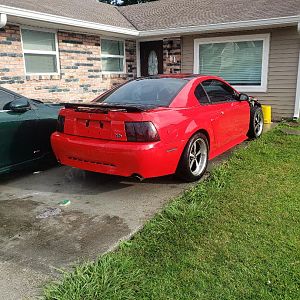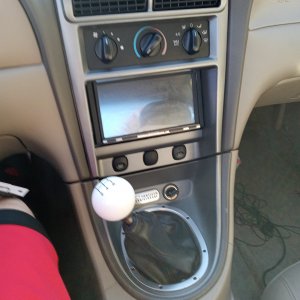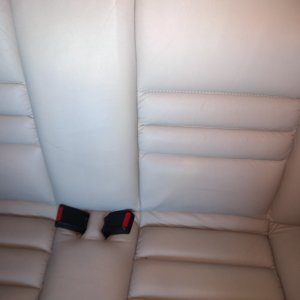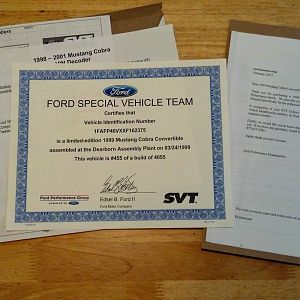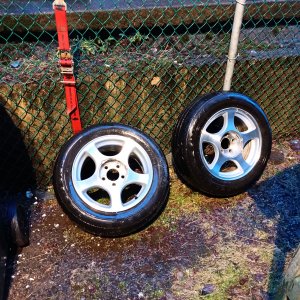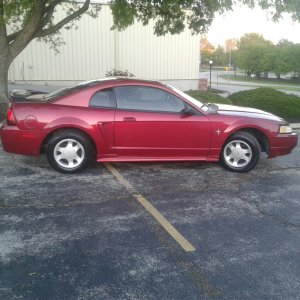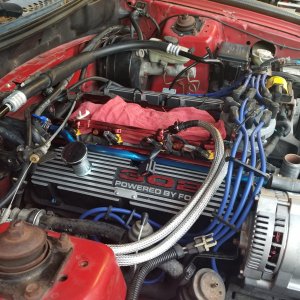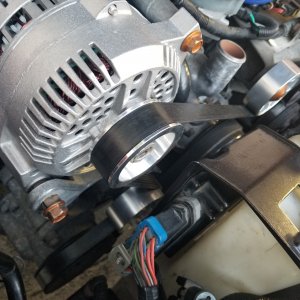97WhitePony
Active Member
- Joined
- May 9, 2006
- Messages
- 264
- Reaction score
- 0
Just 2 Nitrous Articles I wrote a while back, figured I would share... Its a long read, but i think its pretty informative...
What is Nitrous Oxide? Well kids, gather around ole' Uncle Russ and let him tell you a little story about "giggle gas"! Nitrous Oxide is a combo of 2 Nitrogen atoms and 1 Oxygen atom (N2O) this mixture is 36% Oxygen if you were to weigh the molecules. These 3 atoms together are locked until they are heated up really fast, and REALLY hot, then, they CRACK apart and some really neat stuff happens. More about that later. Lets start at the basics! Nitrous was actually first used in WW2 by allied aircraft pilots to give them an extra advantage on how fast they could climb and fly! After turbine engines were invented though, the bottles were put to bed until the 1970s! This is when Mike Thermos and Dale Vaznaian came around and re-invented the nitrous oxide kit! In 1978 these two men formed what we now know as Nitrous Oxide Systems (NOS)! (Just a writer's side note. N.O.S. is an abbreviation not a word! If you want to say NOS (NAWZ) then you should stay away from cars.) Enough of that, moving right along!
We will start at the bottle. Probably the most common bottle used in the world of Nitrous is your basic 10lb bottle. Although nitrous is a gas, when you compress it, it will become a liquid. This happens because the nitrous molecules are forced closer together and move a little slower. This slower movement of molecules gives us our liquid. This liquid cannot be measured in gallons like a gas tank. So we measure it by POUNDS (lbs). So a 10lb Nitrous bottle will hold, well, 10lbs worth of nitrous. This amount is measured at your N20 distributor on a scale called a FREON SCALE. The bottle is pumped full of nitrous as the tech watches the scale closely monitoring how "heavy" the bottle is getting, at 10lbs, the tech cuts off the feed, and you now have a full bottle of "Go Juice". READ ON there�s more!
Next, off the bottle, we will look at the different lines and valves, called "plumbing". To stop the N2O from exiting the bottle, a manual valve sits there that you can open and close MANUALLY (go figure). This can be substituted with a valve called a "remote bottle opener" (this will be covered in another article) but for now it isn�t important. Just know that when the valve is open, out comes N2O and when its closed, it stays in. The line that will run from the bottle to your engine compartment is high-pressure braided steel line. These lines are sized by a special measurement called AN. AN sizes, originally developed for use by the U.S. Armed forces ("A" for army and "N" for navy), describe the outside diameter (O.D.) of tubing in 1/16-inch increments. For example, an AN 2 fitting will fit a tube with an O.D. of 2/16", or 1/8", while an AN 8 fitting will fit a tube with an O.D. of 8/16", or 1/2". Because the actual thickness of tube walls can vary from brand to brand, the inside diameter of a tube is not used as a reference. You will also find the dash (-) symbol or the word "dash" itself used in conjunction with AN sizes. A "dash six" fitting translates to AN-6. Another type of measurement you will encounter is called NPT (National Pipe Taper). NPT are the most commonly used fitting sizes for general plumbing, piping, and tubing use; not quite as popular as AN for automotive use, but still very common. While AN fittings depend on the outside diameter of a tube for sizing, NPT fittings depend on the interior diameter (I.D.) of the fitting itself.
Moving right along the main nitrous line, we will hit what is called a Nitrous Solenoid. This is a magnetic valve called a NEEDLE VALVE. That when electricity is passed over it, opens really fast. The speed at which this valve opens is measured in milliseconds (ms). On the OUT side of the solenoid is yet another high-pressure steel line. This line will go into your intake usually through a nozzle or a throttle plate, depending on your application. At this point, the nitrous will either blend with FUEL (for a wet kit) or just get sucked into your intake. More on the wet kit setup in the articles to come.
As the nitrous enters your intake, it will enter a cylinder (which ever one is on its intake stroke) as it enters into the cylinder, the piston will begin to rise back up towards top dead center. During the combustion process in an engine, at about 572 degrees F, nitrous breaks down and releases the oxygen atom. This extra oxygen that has been released, creates the ability to burn more fuel (the more fuel you can burn, the more HP you can make). The left over nitrogen acts to buffer, or dampen the increased cylinder pressures helping to control the combustion process. Nitrous also has a tremendous "intercooling" effect by reducing intake charge temperatures by 60 to 75deg F!! This is a very good thing!
Russ Conrad - 97WhitePony :bunny3:
What is Nitrous Oxide? Well kids, gather around ole' Uncle Russ and let him tell you a little story about "giggle gas"! Nitrous Oxide is a combo of 2 Nitrogen atoms and 1 Oxygen atom (N2O) this mixture is 36% Oxygen if you were to weigh the molecules. These 3 atoms together are locked until they are heated up really fast, and REALLY hot, then, they CRACK apart and some really neat stuff happens. More about that later. Lets start at the basics! Nitrous was actually first used in WW2 by allied aircraft pilots to give them an extra advantage on how fast they could climb and fly! After turbine engines were invented though, the bottles were put to bed until the 1970s! This is when Mike Thermos and Dale Vaznaian came around and re-invented the nitrous oxide kit! In 1978 these two men formed what we now know as Nitrous Oxide Systems (NOS)! (Just a writer's side note. N.O.S. is an abbreviation not a word! If you want to say NOS (NAWZ) then you should stay away from cars.) Enough of that, moving right along!
We will start at the bottle. Probably the most common bottle used in the world of Nitrous is your basic 10lb bottle. Although nitrous is a gas, when you compress it, it will become a liquid. This happens because the nitrous molecules are forced closer together and move a little slower. This slower movement of molecules gives us our liquid. This liquid cannot be measured in gallons like a gas tank. So we measure it by POUNDS (lbs). So a 10lb Nitrous bottle will hold, well, 10lbs worth of nitrous. This amount is measured at your N20 distributor on a scale called a FREON SCALE. The bottle is pumped full of nitrous as the tech watches the scale closely monitoring how "heavy" the bottle is getting, at 10lbs, the tech cuts off the feed, and you now have a full bottle of "Go Juice". READ ON there�s more!
Next, off the bottle, we will look at the different lines and valves, called "plumbing". To stop the N2O from exiting the bottle, a manual valve sits there that you can open and close MANUALLY (go figure). This can be substituted with a valve called a "remote bottle opener" (this will be covered in another article) but for now it isn�t important. Just know that when the valve is open, out comes N2O and when its closed, it stays in. The line that will run from the bottle to your engine compartment is high-pressure braided steel line. These lines are sized by a special measurement called AN. AN sizes, originally developed for use by the U.S. Armed forces ("A" for army and "N" for navy), describe the outside diameter (O.D.) of tubing in 1/16-inch increments. For example, an AN 2 fitting will fit a tube with an O.D. of 2/16", or 1/8", while an AN 8 fitting will fit a tube with an O.D. of 8/16", or 1/2". Because the actual thickness of tube walls can vary from brand to brand, the inside diameter of a tube is not used as a reference. You will also find the dash (-) symbol or the word "dash" itself used in conjunction with AN sizes. A "dash six" fitting translates to AN-6. Another type of measurement you will encounter is called NPT (National Pipe Taper). NPT are the most commonly used fitting sizes for general plumbing, piping, and tubing use; not quite as popular as AN for automotive use, but still very common. While AN fittings depend on the outside diameter of a tube for sizing, NPT fittings depend on the interior diameter (I.D.) of the fitting itself.
Moving right along the main nitrous line, we will hit what is called a Nitrous Solenoid. This is a magnetic valve called a NEEDLE VALVE. That when electricity is passed over it, opens really fast. The speed at which this valve opens is measured in milliseconds (ms). On the OUT side of the solenoid is yet another high-pressure steel line. This line will go into your intake usually through a nozzle or a throttle plate, depending on your application. At this point, the nitrous will either blend with FUEL (for a wet kit) or just get sucked into your intake. More on the wet kit setup in the articles to come.
As the nitrous enters your intake, it will enter a cylinder (which ever one is on its intake stroke) as it enters into the cylinder, the piston will begin to rise back up towards top dead center. During the combustion process in an engine, at about 572 degrees F, nitrous breaks down and releases the oxygen atom. This extra oxygen that has been released, creates the ability to burn more fuel (the more fuel you can burn, the more HP you can make). The left over nitrogen acts to buffer, or dampen the increased cylinder pressures helping to control the combustion process. Nitrous also has a tremendous "intercooling" effect by reducing intake charge temperatures by 60 to 75deg F!! This is a very good thing!
Russ Conrad - 97WhitePony :bunny3:

